Teaching algebra with manipulatives
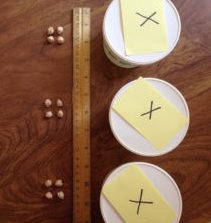
by Kathy Kuhl
Teaching parents in Fort Worth last month, I promised to explain bean algebra—a way to solve linear equations using beans. (I learned this when I was a new public school math teacher in 1979, and I cannot remember or find the source. If you know, tell me.)
What manipulatives you’ll need
Manipulatives are simply objects you handle to help you grasp a concept. (Pun intended.) For bean algebra you need:

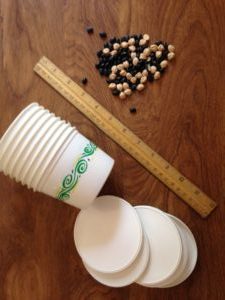
- a ruler or other long object to divide the workspace into two areas (or you could use two shallow boxes, a line on your table—anything to divide two areas)
- Navy beans or other dried light-colored beans (Today I’m using garbanzo beans.)
- Black beans or other dried dark beans
- 8 or 9 identical small opaque containers with lids (I use empty margarine containers. If you use something with clear sides, line them with paper so the person solving the puzzle cannot see inside.)
Here’s how to create a bean algebra equation
To create a equation with beans, let’s begin with simple equations like 10 = 2x. (We’ll get to more complex linear equations—in y=mx + b form—next week.)
Let your child build them, too, because it’s good practice for problem solving.
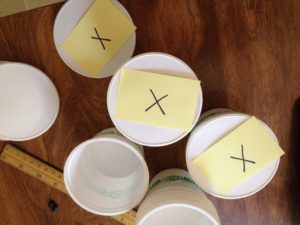
The containers represent the variable x. I’m going to label mine on the lid like this.
To begin to create a problem, decide what x will be and put that many beans in the container. For our example, I chose that x would be 4. (To introduce the idea, I might call it “Our mystery number.”) So I put 4 beans in one container and snap on the lid.
Equations have equal value on both sides of the equals sign. When you build an equation with bean algebra, you must have equal value on both sides of the ruler (or other divider).
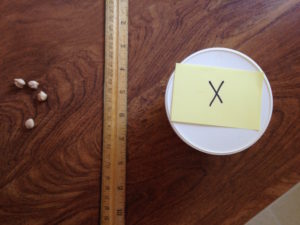
So if I put my container with 4 beans on one side, I must put four beans on the other side, too. That shows x = 4. If my students knows both sides are equal and can see one container on one side and four beans on the other, they know 4 = x. That’s a simple, but pretty boring equation. Not much of a puzzle yet.
Let’s make it more interesting. Let’s put another container on the left. (Remember, we decided for this problem x = 4), so we have to put four beans in each container, and we put more beans on the right. Now we are showing 2x = 8.
Let’s do that again and show 3x = 12 or 12 = 3x. (Make sure your child knows this property, which called symmetry. Practice with words: “My dog is Max. Max is my dog.” If a = b, then b = a.)
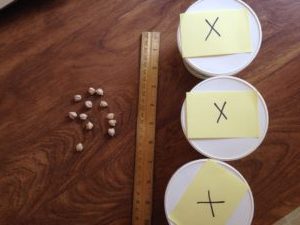
Let’s switch to solving equations. Suppose you set up your puzzle before the child came into the room. Begin by showing the child 12 = 3x, and you explain that for every puzzle, each of the containers have the same number of beans. How could they solve it?

Here’s one way, but your kids may come up with good alternatives. (Please share them in the comments below.) He or she could divide the beans on the right to line up with the containers on the left and make three groups of four beans. Then we could see there must be four beans per container.
Notice I put each group of 4 beans in a square. It’s good to teach and reinforce the number patterns you find on dice and dominos to help struggling learners recognize these groups.
Then pop open the lids to check your work.
Practice creating and solving
Next tell them you’re thinking of a new secret number, and repeat with 2x = 10, 5x = 15, 3x = 15, and so on. Be sure you also say 10= 2x, 15 = 5x, etc., because the order doesn’t matter.
Practice until the child is comfortable solving those kinds of problems, which all follow the pattern y=mx, or in English, y equals some number of x’s, where x is the number of beans in the container.
Also, let your child begin to set up problems for you. For struggling learners, counting and double-checking the number of beans on each side and in each container would be wise. I would have a child set up a problem with the lids off the containers, to make it easier to double check. Then close the lids, and we’re ready to put on the lids and go ask Dad or brother to solve the puzzle.
Next time we’ll make the puzzle a little more interesting.
How do you use manipulatives to teach beginning algebra? Please enter your ideas in the comment section below?
This 4-part series began here, and continues here: Part 3, and Part 4.

